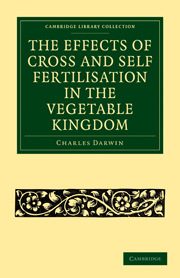Book contents
- Frontmatter
- Contents
- CHAPTER I INTRODUCTORY REMARKS
- CHAPTER II CONVOLVULACEÆ
- CHAPTER III SCROPHULARIACEÆ, GESNERIACEÆ, LABIATÆ, ETC
- IV CRUCIFERÆ, PAPAVERACEÆ, RESEDACEÆ, ETC
- CHAPTER V GERANIACEÆ, LEGUMINOSÆ, ONAGRACEÆ, ETC
- CHAPTER VI SOLANACEÆ PRIMULACEÆ, POLYGONEÆ, ETC
- CHAPTER VII SUMMARY OF THE HEIGHTS AND WEIGHTS OF THE CROSSED AND SELF-FERTILISED PLANTS
- CHAPTER VIII DIFFERENCE BETWEEN CROSSED AND SELF-FERTILISED PLANTS IN CONSTITUTIONAL VIGOUR AND IN OTHER RESPECTS
- CHAPTER IX THE EFFECTS OF CROSS-FERTILISATION AND SELF-FERTILISATION ON THE PRODUCTION OF SEEDS
- CHAPTER X MEANS OF FERTILISATION
- CHAPTER XI THE HABITS OF INSECTS IN RELATION TO THE FERTILISATION OF FLOWERS
- CHAPTER XII GENERAL RESULTS
- INDEX
CHAPTER V - GERANIACEÆ, LEGUMINOSÆ, ONAGRACEÆ, ETC
Published online by Cambridge University Press: 29 August 2010
- Frontmatter
- Contents
- CHAPTER I INTRODUCTORY REMARKS
- CHAPTER II CONVOLVULACEÆ
- CHAPTER III SCROPHULARIACEÆ, GESNERIACEÆ, LABIATÆ, ETC
- IV CRUCIFERÆ, PAPAVERACEÆ, RESEDACEÆ, ETC
- CHAPTER V GERANIACEÆ, LEGUMINOSÆ, ONAGRACEÆ, ETC
- CHAPTER VI SOLANACEÆ PRIMULACEÆ, POLYGONEÆ, ETC
- CHAPTER VII SUMMARY OF THE HEIGHTS AND WEIGHTS OF THE CROSSED AND SELF-FERTILISED PLANTS
- CHAPTER VIII DIFFERENCE BETWEEN CROSSED AND SELF-FERTILISED PLANTS IN CONSTITUTIONAL VIGOUR AND IN OTHER RESPECTS
- CHAPTER IX THE EFFECTS OF CROSS-FERTILISATION AND SELF-FERTILISATION ON THE PRODUCTION OF SEEDS
- CHAPTER X MEANS OF FERTILISATION
- CHAPTER XI THE HABITS OF INSECTS IN RELATION TO THE FERTILISATION OF FLOWERS
- CHAPTER XII GENERAL RESULTS
- INDEX
Summary
GERANIACEÆ.—Pelargonium zonale.
This plant, as a general rule, is strongly proterandrous, and is therefore adapted for cross-fertilisation by the aid of insects. Some flowers on a common scarlet variety were self-fertilised, and other flowers were crossed with pollen from another plant; but no sooner had I done so, than I remembered that these plants had been propagated by cuttings from the same stock, and were therefore parts in a strict sense of the same individual. Nevertheless, having made the cross I resolved to save the seeds, which, after germinating on sand, were planted on the opposite sides of three pots. In one pot the quasi-crossed plant was very soon and ever afterwards taller and finer than the self-fertilised. In the two other pots the seedlings on both sides were for a time exactly equal; but when the self-fertilised plants were about 10 inches in height, they surpassed their antagonists by a little, and ever afterwards showed a more decided and increasing advantage; so that the self-fertilised plants, taken altogether, were somewhat superior to the quasi-crossed plants. In this case, as in that of the Origanum, if individuals which have been asexually propagated from the same stock, and which have been long subjected to the same conditions, are crossed, no advantage whatever is gained.
Several flowers on another plant of the same variety were fertilised with pollen from the younger flowers on the same plant, so as to avoid using the old and long-shed pollen from the same flower, as I thought that this latter might be less efficient than fresh pollen.
- Type
- Chapter
- Information
- Publisher: Cambridge University PressPrint publication year: 2009First published in: 1876

